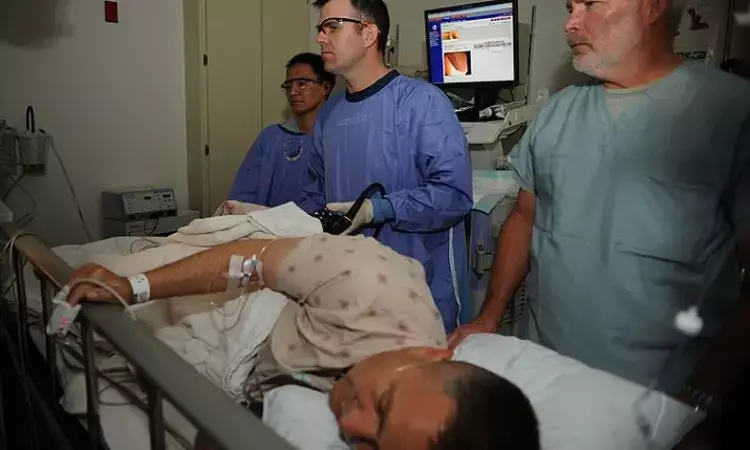- Home
- Medical news & Guidelines
- Anesthesiology
- Cardiology and CTVS
- Critical Care
- Dentistry
- Dermatology
- Diabetes and Endocrinology
- ENT
- Gastroenterology
- Medicine
- Nephrology
- Neurology
- Obstretics-Gynaecology
- Oncology
- Ophthalmology
- Orthopaedics
- Pediatrics-Neonatology
- Psychiatry
- Pulmonology
- Radiology
- Surgery
- Urology
- Laboratory Medicine
- Diet
- Nursing
- Paramedical
- Physiotherapy
- Health news
- Fact Check
- Bone Health Fact Check
- Brain Health Fact Check
- Cancer Related Fact Check
- Child Care Fact Check
- Dental and oral health fact check
- Diabetes and metabolic health fact check
- Diet and Nutrition Fact Check
- Eye and ENT Care Fact Check
- Fitness fact check
- Gut health fact check
- Heart health fact check
- Kidney health fact check
- Medical education fact check
- Men's health fact check
- Respiratory fact check
- Skin and hair care fact check
- Vaccine and Immunization fact check
- Women's health fact check
- AYUSH
- State News
- Andaman and Nicobar Islands
- Andhra Pradesh
- Arunachal Pradesh
- Assam
- Bihar
- Chandigarh
- Chattisgarh
- Dadra and Nagar Haveli
- Daman and Diu
- Delhi
- Goa
- Gujarat
- Haryana
- Himachal Pradesh
- Jammu & Kashmir
- Jharkhand
- Karnataka
- Kerala
- Ladakh
- Lakshadweep
- Madhya Pradesh
- Maharashtra
- Manipur
- Meghalaya
- Mizoram
- Nagaland
- Odisha
- Puducherry
- Punjab
- Rajasthan
- Sikkim
- Tamil Nadu
- Telangana
- Tripura
- Uttar Pradesh
- Uttrakhand
- West Bengal
- Medical Education
- Industry
Abdominal Binder good for colonoscopy in young and obese patients,finds study

Abdominal Binder use in selected patients may be advantageous during colonoscopy because it reduces the need for analgesics and post-procedure pain, and reduces the need for auxiliary maneuvers in relatively young and obese patients, suggests findings from a new study put forth in Scandinavian Journal of Gastroenterology.
Prolongation of cecal intubation time (CIT) directly affects the comfort of the patient and the colonoscopist. In this study, the effectiveness of using an abdominal binder (AB) during colonoscopy on procedure time and colonoscopy outcomes was investigated.
The authors of this double-blind, randomized, sham-controlled study evaluated the effectiveness of using an abdominal binder during colonoscopy.
For the current study researchers conducted a parallel randomized double-blind sham-device-controlled study of patients who underwent elective outpatient colonoscopy between 1 May 2020, and 31 August 2020. Participants were randomly assigned to AB (n = 173) and sham binder (SB) (n = 173) groups. The primary outcome was CIT. Secondary outcomes were the need for auxiliary maneuvers, the cecum intubation length (CIL) of the colonoscope, visual analog scale (VAS) score, narcotic analgesic dose, and colonoscopy results. Moreover, subgroup analysis was performed in terms of age and obesity indices.
Results highlighted some interesting facts.
- A total of 346 patients were enrolled in the study. The mean CIT was similar between groups (AB group 240 secs, control group 250 secs, p > .05).
- Manual pressure requirement was less in the AB group (27 vs. 36%, p = .069). VAS score and the need for extra narcotic analgesic drugs were prominently lower in the AB group (p < .001, p = .016, respectively).
- In the subgroup analyses, in participants at the age of <60 and waist-to-height ratio (WHtR) ≥0.5, manual pressure requirements were significantly shorter in the AB group (p = .017, p = .032, respectively).
"There was no difference in cecal intubation time or in the need for auxiliary maneuvers such as manual pressure or position change, but use of the abdominal binder was associated with less procedural pain and less need for extra doses of narcotic analgesics. In subgroup analysis, in patients younger than 60 years and in those with a waist-to-height ratio ≥0.5, manual pressure requirements were less in the abdominal binder group (P = .017 and P = .032, respectively).The use of an abdominal binder may be beneficial in select patients during colonoscopy as it may reduce postprocedural pain and the need for analgesics and may also reduce the need for auxiliary maneuvers in young patients with obesity."the team concluded.
For full article follow link: https://doi.org/10.1080/00365521.2021.1941238
Source: Scandinavian Journal of Gastroenterology
Dr Satabdi Saha (BDS, MDS) is a practicing pediatric dentist with a keen interest in new medical researches and updates. She has completed her BDS from North Bengal Dental College ,Darjeeling. Then she went on to secure an ALL INDIA NEET PG rank and completed her MDS from the first dental college in the country – Dr R. Ahmed Dental College and Hospital. She is currently attached to The Marwari Relief Society Hospital as a consultant along with private practice of 2 years. She has published scientific papers in national and international journals. Her strong passion of sharing knowledge with the medical fraternity has motivated her to be a part of Medical Dialogues.
Dr Kamal Kant Kohli-MBBS, DTCD- a chest specialist with more than 30 years of practice and a flair for writing clinical articles, Dr Kamal Kant Kohli joined Medical Dialogues as a Chief Editor of Medical News. Besides writing articles, as an editor, he proofreads and verifies all the medical content published on Medical Dialogues including those coming from journals, studies,medical conferences,guidelines etc. Email: drkohli@medicaldialogues.in. Contact no. 011-43720751


